
Cross-cultural research should be a key ingredient in your user experience, customer experience, and global messaging research plans. A cross-cultural framework, especially when applied early to your strategy and development, can help you connect with global customers on their terms. In this article, I’ll show how to leverage a framework known as the 6-D Model to create localized experiences for your customers. By way of example, I look at why Japanese websites differ in design and user experience from the same sites created for Western users.
Using Cross-Cultural Research in UX Research & Messaging
Cultures are different. It makes sense that user preferences differ too. Localizing the customer experience requires a nuanced understanding of how people interpret your message, how they process information, and the types of experiences they value. Cross-cultural research is key to creative and experiential localization. It is not language-based and doesn’t simply strive for accurate and culturally attuned translations. Rather, cross-cultural research looks at how values, beliefs, and behaviors underpin what kinds of messages and user experiences drive desired actions.
One framework that’s used by researchers, including those specializing in user experience research, customer experience research, and ethnography, is Geert Hofstede’s theory of cultural dimensions, also known as the 6-D Model. There’s a lot to this theory that we don’t need to unpack here, but here’s a quick overview.
Hofstede was a social psychologist who looked at the effects of culture—both the culture of nations and the culture of organizations—on the preferences of its members. He and his research team developed a sociological survey to measure the preference of one state of being over another and used the data to distinguish national preferences on a 0 to 100 scale. He drew up indices reflecting national cultural characteristics of a country, which he called ‘cultural dimensions’.
Cross-Cultural Research & The 6-D Model
There were originally four and now six cultural dimensions, hence the 6-D Model. Each dimension indicates the degree to which a country:
- Is more or less hierarchical
- Prioritizes the individual or the collective
- Prioritizes ‘masculine’ values or ‘feminine’ values (We are not fans of the gender stereotypes associated with this metric)
- Is more or less risk-averse
- Preserves tradition or seeks change
- Restrains gratification or indulges it
Here’s more on how these dimensions are defined and measured:

By way of illustration, take a look at Denmark and Sweden.
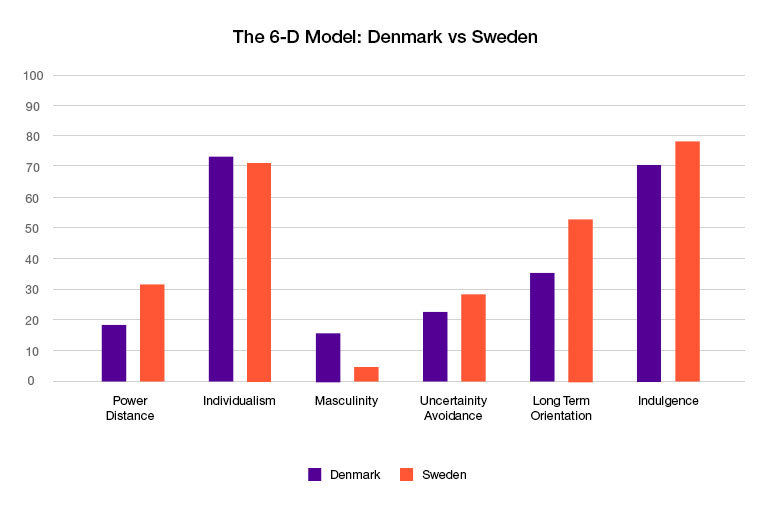
Source: hofstede-insights.com
These countries rate similarly across the 6-D board. Now, ask a Swede or a Dane, and each would invariably provide you with a host of differences between their respective countries. And they’d be justified in doing so. The 6-D Model is not a substitute for deep dives into nuanced cultural distinctions. But what cultural dimensions scores can tell you is that relative to each other, these countries are close in most of their preferences for one state of being over another.
You could note that Swedes, generally, maybe more risk-averse than Danes. Though compared to Germany, which scores 83 on Long Term Orientation, Sweden would look like a land of risk-takers. The important thing to remember about the 6-D model and country comparisons is that they are just that, comparisons. Scores are relative differentiators, not judgments.
In contrast, take a look at Japan and the United States. There are some dramatic differences between how these two countries compare on the six cultural dimensions.
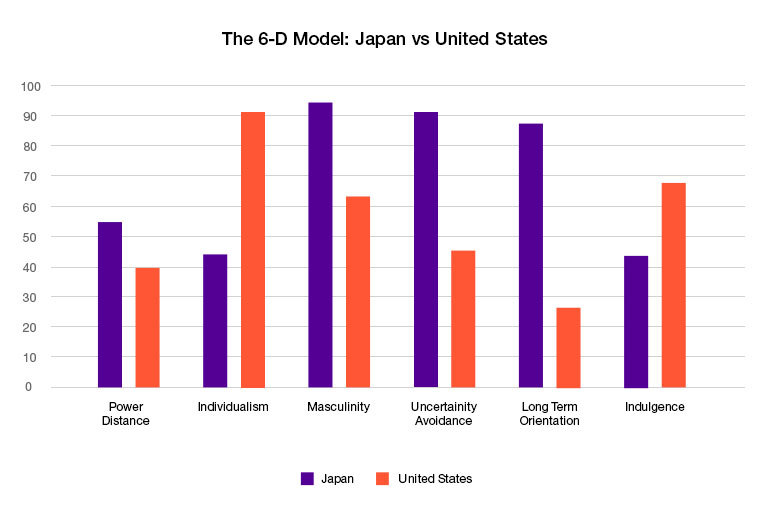
Understanding how these differences manifest in terms of needs, what types of messages resonate, and how people want to receive information about your brand is the essential work of user experience research, customer experience research, messaging research, and global consumer insights in general.
Combining Cross-Cultural Research with Customer & User Research to Create Localized Experiences
Culturally attuned UX research provides a useful baseline understanding of customer preferences, especially in the Discovery phase of research and development. The 6-D Model can be a useful lens for understanding how and why customer experience and design preferences are different across cultures. Whether it is a user interface, an in-store experience, or a visual design, our cultural biases inform how we process information and interact with it.
Knowing early on what those cultural predispositions are and how to leverage them is a key factor in the early stages of product development, customer experience, interaction design, product marketing, global campaign strategy, etc.
Which brings us (naturally?) to Japanese websites. To the Western brain, Japanese websites are confusing (and this isn’t just because Google Translate has trouble with Kanji). Japanese sites typically condense a maximum amount of information on one page. Images are deprioritized in favor of the text. Take a look at the same day’s edition of the Japanese news site Yomiuri compared to its English language version, The Japan News.
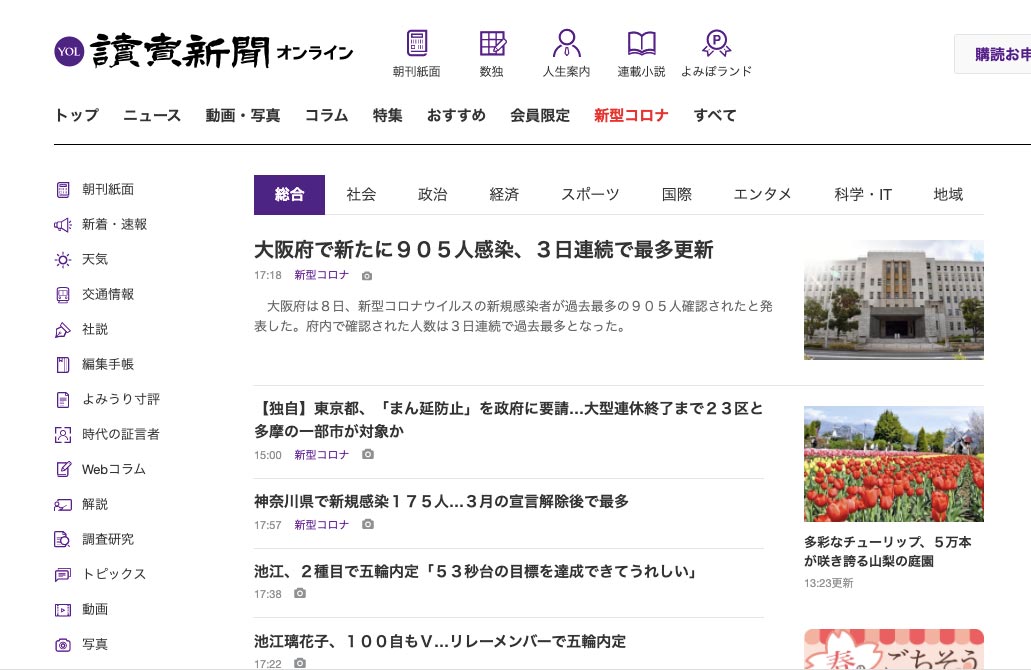
Source: yomiuri.co.jp

Source: the-japan-news.com
Yomiuri owns The Japan News, and both sites carry the same content, but one caters to locals and the other to Westerners. The layout of The Japan News is familiar to the Westerners, with the feature story above the fold, alongside a prominent visual. In contrast, Yomiuri presents more information within the same amount of space, utilizing a 3-column layout, with smaller images of equal proportion. Somewhat like Japan itself, where space is at a premium, and none is wasted, Japanese sites tend to pack a lot into a homepage, with multiple columns, lengthy text, and tiny images. For example, Yomiuri has a left-hand column with 32 content options, whereas The Japan News includes only a handful of these contained within subpages.
This tendency to pack a lot of information into a small space can, in part, be attributed to Japan being an early adopter of the mobile web. Back when websites were largely brochureware, computer screens, and mobile screens were smaller, the design made sense. But it does not explain why so many sites still appear this way.
Cultural factors can explain this. Using the 6-D Model, you can see that Japan ranks much higher for Uncertainty Avoidance, meaning that compared to Americans, Japanese are more risk-averse. The text-packed and multi-optioned Yomiuri design is rooted, in part, in risk aversion. Why? One aspect of lowering risk means having as much information as possible available to you to make a decision. It means knowing what you’re getting. Japanese consumers tend to want more information upfront. Print publications also follow this design principle. This is why packaging, adverts, and even television programming can appear confusing and cluttered to the Western eye. While there is some hierarchy to the information presented, the tendency is to utilize space to provide more data points so users can make a fully informed decision.
This is also seen in commercial websites like Rakuten (a popular Japanese affiliate site), where users are routed to other online retailers for cashback on purchases. Visit the site and you’ll see a banner with a carousel of rotating product categories and deals.

Source: rakuten.co.jp
Scroll down the page and you’ll see a left-hand column of content categories, similar to Yomiuri, with thumbnails of products and promotions. Again, the layout speaks to the risk-averse consumer who needs to weigh all of their options.
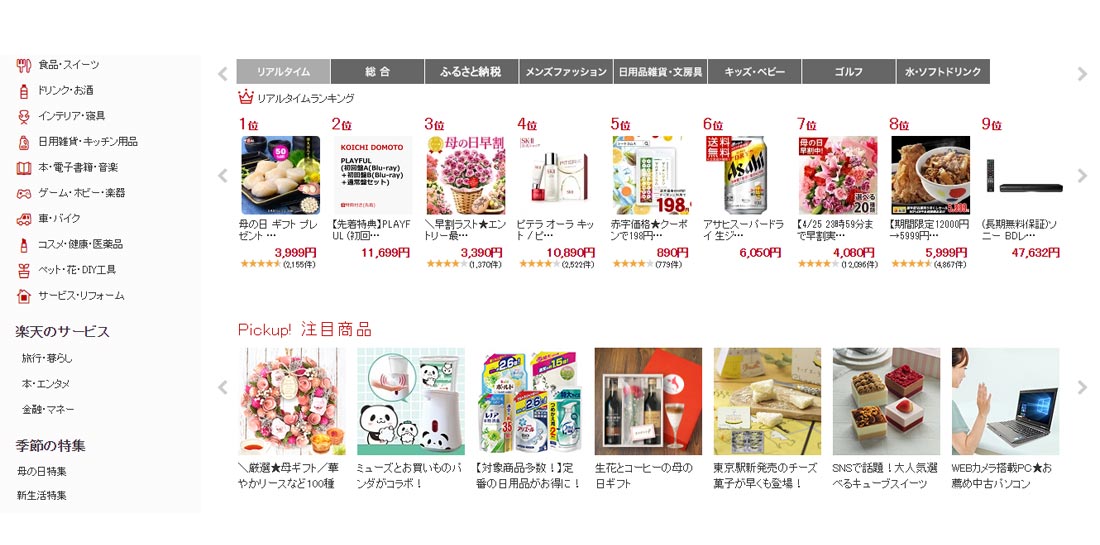
Compare this to rakuten.com, the US version. It features a single banner, a human figure, and an emotion-driven message. The message is about how cashback makes you feel and less about the tangible benefits of how much you’ll save. The takeaway is the emotional benefit that the brand delivers.
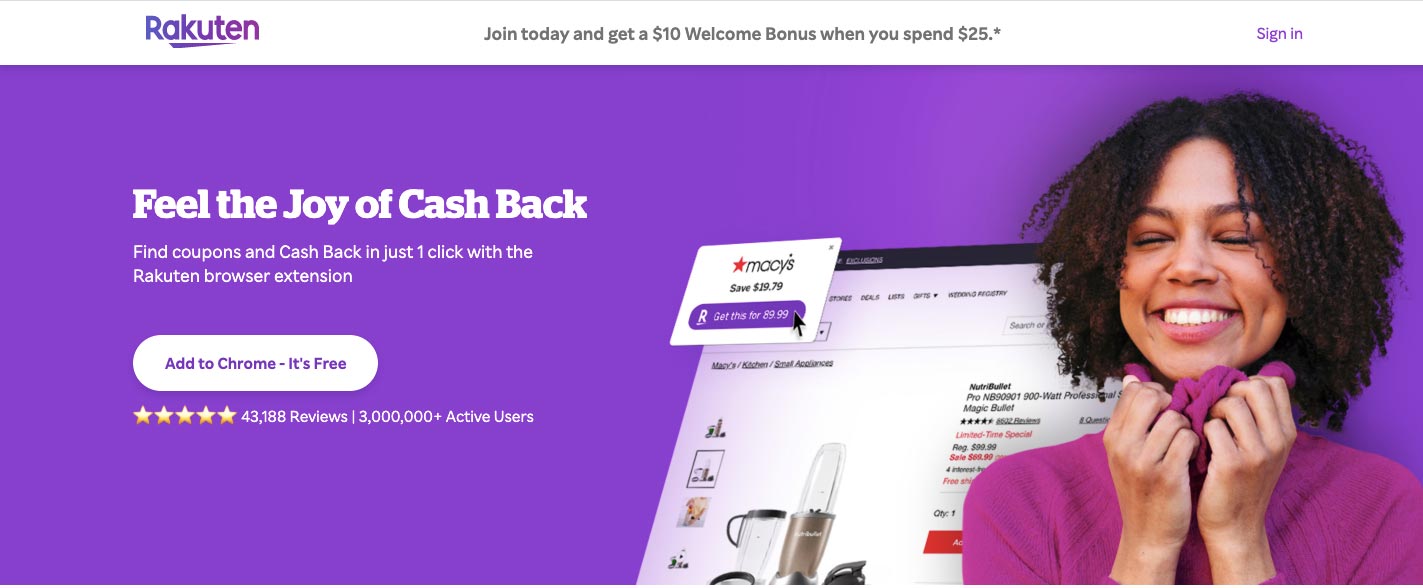
Feeling the joy’ of Rakuten begins with a single action: downloading the extension. Users scroll down to learn more about how the service works, but the information is minimal. The UX is intended to deliver quick gratification without a lot of data in between. Remember, the US scores 46 on Uncertainty Avoidance, whereas Japan scores 92. That means that as a culture, Americans are more comfortable with uncertainty. US users (for better or worse) are okay not knowing everything before making a decision. In contrast, a Japanese user may be more risk-averse and needs more information before taking any action.
Another difference in design, messaging, and UX is driven by the Individualism measure. The US prizes individualism, with a score of 90 on individualism vs. collectivism. In contrast, Japan puts the collective ahead of the individual, scoring 46 on this measure. Rakuten’s US site features an individual in the banner with a focus on feeling. The emotional needs of the individual are at the core of the message.
Finally, you’d expect the combination of the brand promise (joy) and a direct action (the extension download) to be motivating for an Indulgence culture. The US scores 26 points higher on Indulgence than Japan, and this too is reflected in the website design. Gratification promises to be easy and instant.
To further underscore how cross-cultural research can inform design, messaging, and UX, take a look at a global campaign from Gap. The message here is that the brand helps you define yourself, your individuality. However, Japan leans towards Collectivism over Individualism. For Japan, creative localization for this campaign required featuring the family, a form of a collective or in-group, as an expression of individualism.
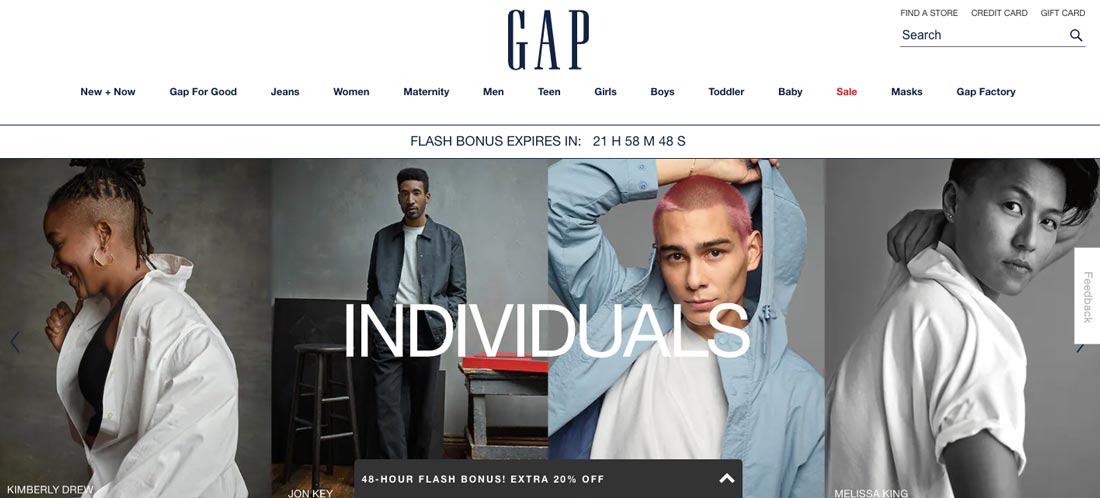
Source: gap.com
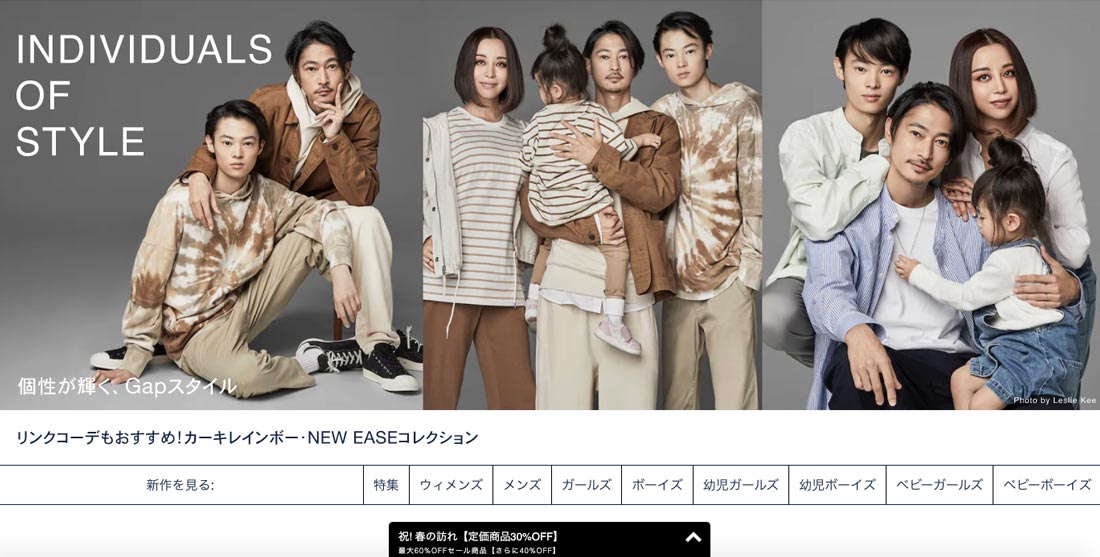
Source: gap.co.jp
The difference in focus on the Individual, Femininity and Indulgence is again evident in Skymark Airlines’ US website. Skymark is a Japanese domestic low-cost airline. Its English language website features a static and visually arresting banner image: a woman looking into a bright blue sky, presumably imagining her travel possibilities. There’s a simple tagline: Your Wing. The image and the copy evoke indulgence, spontaneity, and individualism.

Source: skymark.jp/en
Compare this to Skymark’s local site, which features a rotating banner of rates, destinations, and last-minute deals. This site focuses on providing users with sufficient information to make an informed decision instead of imagining possibilities.

Source: skymark.jp
When should Cross-Cultural Research be Used
The simple answer is early on, in the discovery phase of a research plan. Multinational brands need to tailor their experiences to meet the culturally ingrained needs and preferences of their customers. The 6-D Model is an excellent starting point. It provides insights into the generalized preferences of a market. A researcher versed in cultural insights can help you understand how those preferences might be manifested with respect to your brand or customer experience and how these needs can be met through your product and user experience. Cross-cultural research is a valuable component of UX research and product development. Whatever your objective is, if your audience spans cultures, this approach will help you ‘get it right’ while eliminating the cost of ‘doing it over.’
The 6-D Model is not a magic bullet. The nature of your industry, your competitive environment, and the many non-cultural dimensions of your customers need to be considered. In addition, people adopt multiple roles and identities that can evolve with life stages. And of course, within cultures are sub-cultures. So no, culture isn’t everything. But it is a remarkably powerful, and according to Hofstede, measurable determinant of our preferences and behaviors.
Interested in cross-cultural research for your next global project?








